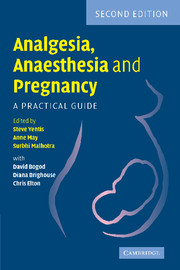Book contents
- Frontmatter
- Contents
- List of contributors
- Preface
- SECTION 1 PRECONCEPTION AND CONCEPTION
- SECTION 2 PREGNANCY
- I Procedures in early/mid-pregnancy
- II Normal pregnancy and delivery
- III Operative delivery and third stage
- IV Anaesthetic complications
- V Problems confined to obstetrics
- VI Problems not confined to obstetrics
- VII The neonate
- SECTION 3 PUERPERIUM AND AFTER
- SECTION 4 ORGANISATIONAL ASPECTS
- Index
II - Normal pregnancy and delivery
Published online by Cambridge University Press: 10 November 2010
- Frontmatter
- Contents
- List of contributors
- Preface
- SECTION 1 PRECONCEPTION AND CONCEPTION
- SECTION 2 PREGNANCY
- I Procedures in early/mid-pregnancy
- II Normal pregnancy and delivery
- III Operative delivery and third stage
- IV Anaesthetic complications
- V Problems confined to obstetrics
- VI Problems not confined to obstetrics
- VII The neonate
- SECTION 3 PUERPERIUM AND AFTER
- SECTION 4 ORGANISATIONAL ASPECTS
- Index
Summary
ANATOMY OF THE SPINE AND PERIPHERAL NERVES
Although not exclusive to obstetric anaesthesia, a sound knowledge of the anatomy pertinent to epidural and spinal anaesthesia is fundamental to obstetric anaesthetists because of the importance of these techniques in this field. In addition, knowledge of the relevant peripheral nerves is important in order to differentiate central from peripheral causes of neurological impairment.
The structures involved in obstetric neuraxial anaesthesia comprise the vertebrae and sacral canal, vertebral ligaments, epidural space, meninges and spinal cord. The important peripheral aspects are the lumbar and sacral plexi and the muscular and cutaneous supply of the lower part of the body.
Vertebrae (Fig. 10.1)
The vertebral column has two curves, with the cervical and lumbar regions convex anteriorly and the thoracic and sacral regions concave. Traditionally, T4 is described as the most posterior part (most dependent in the supine position), although T8 has been suggested by recent imaging studies. L3–4 is the most anterior part (uppermost in the supine position), although this curve may be flattened by flexing the hips. In the lateral position, the greater width of women's hips compared with their shoulders imparts a downward slope from the caudal end of the vertebral column to the cranial end.
- Type
- Chapter
- Information
- Analgesia, Anaesthesia and PregnancyA Practical Guide, pp. 18 - 79Publisher: Cambridge University PressPrint publication year: 2007



